ERA Country Report 2023
France
Edited by Natalia Altman (Ecorys)
as part of ‘Development of the ERA Scoreboard, the ERA Dashboard and the Regular Reports’ project for the European Commission, Directorate-General for Research and Innovation under Framework Contract N° 2018/RTD/A2/OP/PP-07001-2018 Lot 2 (EDAR)
Click here to download this country report![]()
- Table of contents
-
ERA Country Report 2023: France
1. National context
1.1. Overview of the ERA policy agenda implementation
1.2. Policy context
2. Assessment of the Implementation of the ERA Policy Agenda and ERA Priorities
2.1. ERA Priority 1: Deepening a truly functional internal market for knowledge
2.2. ERA Priority 2: Taking up together the challenges posed by the twin green and digital transition and increasing society’s participation in the ERA
2.3. ERA Priority 3: Amplifying access to research and innovation excellence across the Union
2.4. ERA Priority 4: Advancing concerted research and innovation investments and reforms
3. Country-specific drivers and barriers
4. Final remarks
5. Bibliography
6. Annexes
6.1. Annex 1: Graphs
ERA Country Report 2023: France
|
Key takeaways:
|
1. National context
1.1. Overview of the ERA policy agenda implementation
France is highly committed to the implementation of the ERA Policy Agenda and has pledged to support all ERA Actions. France is considered a strong innovator, with performance at 105.4% of the EU average, according to the European Innovation Scoreboard. Performance in 2023, when compared to 2016, has increased for almost all Member States, except for France and Luxembourg. ^ Between 2016 and 2023, innovation performance in France has decreased by approximately 1%. The European Commission Semester Report for France (2023) highlights that, over the last decade, France has not been able to improve the performance of its public research system and fully regain the appeal of academic research careers. ^
The French strategy towards the implementation of the ERA Policy Agenda, and subsequent priorities and actions, encompasses different policy initiatives. The French Recovery and Resilience Plan (RRP) and France 2030 are part of this endeavour and can be acknowledged as key tools to accelerate the green and digital transition. France 2030 combines temporary funding (five years) and national strategies designed to serve as an innovation accelerator. ^ The various lines of action defined under this strategy are interlinked with the priorities defined under the ERA. For instance, France 2030 addresses ERA priorities such as Make EU R&I Missions and Partnerships key contributors to the ERA, an ERA for Green Transformation, Accelerate the Green/Digital Transition of Europe’s Key Industrial Ecosystems.
1.2. Policy context
The French R&I system is characterised by a strong role of the State. ^ Research policy is conducted and managed by the Ministry of Higher Education and Research (MESR). Key entities play significant roles within the research and innovation ecosystem in France. They include the Strategic Research Council which provides advice to the government regarding major policy directions in scientific research, technology transfer, and innovation. ^
Additionally, the High Council for Evaluation of Research and Higher Education operates as an independent administrative public authority. It conducts evaluations of various entities, including higher education institutions, research bodies, scientific cooperation foundations and the French National Research Agency (ANR). ^ The National Commission for the Evaluation of Innovation Policies, established under Strategy France, plays a pivotal role in enhancing the effectiveness and efficiency of innovation policies and inform the decisions of all players in the national innovation system.
The Law on higher education and research sets the framework for the reform of the higher education and research system launched by the French Government in 2012. It focuses on two main priorities: promoting the success of all students and enhancing the ambition and coherence of research, while strengthening its global presence. As a result of this legalisation, the MESR develops both a national higher education strategy and a national research strategy, which are reviewed and updated every five years. ^
As a result of sustained efforts, France is amongst the leaders in relation to participation in Horizon 2020 and Horizon Europe. Over the last three years of the Horizon 2020 programme, France received 10.7% of the allocated grants. In Horizon Europe, France secured 11.1% of the funding already by October 2022 and thus reaffirmed its position as the second-largest recipient of Horizon Europe funding, with only Germany ahead. ^
The RRP and investment plan France 2030 aim to boost innovation in the coming years, particularly through investment in research, development and innovation, targeting strategic sectors such as hydrogen, decarbonisation of industry and advanced digital technologies. ^ As part of the RRP, France has introduced the multiannual programming law on research (2021- 2030), which aims to increase public R&I funding, to promote science-business-citizen linkages, to simplify administrative procedures, as well as to make research careers more attractive. EUR 4.25 billion has been allocated to the Investments for the Future programme to invest in key green and digital technologies and in teaching, research and innovation ecosystems. Launched in 2021, France 2030, integrated with the 4th Investments for the Future programme (PIA 4), will contribute an additional EUR 34 billion to foster innovation and help new ‘champions’ emerge in key sectors. This merger has expanded the total envelope to EUR 54 billion, combining EUR 20 billion from PIA4 with the allocated EUR 34 billion from France 2030.^
2. Assessment of the Implementation of the ERA Policy Agenda and ERA Priorities
This chapter has two objectives: 1) It qualitatively assesses the state-of-play of the implementation of the ERA Actions that France has committed to. The qualitative information primarily stems from the OECD STIP survey 2023, supplemented by further desk research; 2) It quantitatively assesses the country’s progress towards achieving the ERA priorities as set out on the Pact for Research and Innovation in Europe.
| Indicator |
Most recent EU average |
Most Recent Metric |
| Gross Domestic Expenditure on R&D (GERD) as a percentage of GDP |
2.26 (2021) |
2.21 (2021) |
| Government Budget Allocations for R&D (GBARD) as a share of GDP |
0.76 (2021) |
0.71 (2021) |
| Researchers (in full-time equivalent) per million inhabitants |
4,483.4 (2021) |
5,025.4 (2021) |
| Business Enterprise expenditure on R&D (BERD) as a percentage of GDP |
1.49 (2021) |
1.5 (2021) |
Source: compiled by research team based on the ERA Scoreboard and ERA Dashboard indicators
The presented quantitative information is mainly based on the ERA Scoreboard and ERA Dashboard indicators, and covers longer-term trends since 2010. Additionally, general indicators for the overall R&I system are outlined in Table 1. More detailed information on the data and graphs can be found in Annex 1. This report will serve as a baseline for reporting in the future.
2.1. ERA Priority 1: Deepening a truly functional internal market for knowledge
2.1.1. State of play in the implementation of the ERA Actions
In relation to ERA Action 1: Enable the open sharing of knowledge and the re-use of research outputs, including through the development of the European Open Science Cloud (EOSC), France has introduced a National Plan for Open Science 2021-2024. This plan seeks to make open science practices more widespread, facilitate the sharing of research data, and encourage the release of research source codes. ^ Additionally, an Open Science Fund has been established, offering a special budget intended to support the French National Plan for Open Science. Its purpose is to provide financial support for projects and initiatives that contribute to the advancement of open science. A new national research data platform called “Recherche Data Gouv” has been created to encourage the sharing and openness of data produced by French research. It fosters training activities, as well as expertise sharing to make data FAIR. ^
With regard to ERA Action 2: Propose an EU copyright and data legislative framework for research, the French law for a digital republic promulgated in October 2016 encourages the circulation of data and knowledge through the opening up of public and general interest data, the creation of a public data service and free access to public research documents and scientific publications financed from public funds.
As for ERA Action 3: Reform the Assessment System for research, researchers and institutions, Council Conclusions on reforming research assessment and open science have been adopted under the French Presidency of the Council of the EU. The MESR is leading reform initiatives, in line with the opening of the national chapter of CoARA (Coalition for Advancing Research Assessment). 53 French research performing organisations have joined CoARA, the second highest participation rate in the EU. Moreover, the MESR initiated the Contracts of Objectives, Means and Performance in 2023 (succeeding the Strategic Management Dialogue). These contracts serve as agreements between the state and higher education institutions, introducing performance monitoring of institutions as they work toward shared strategic objectives outlined by the ministry and the respective institution(s). These contracts offer additional funding, subject to performance evaluation, allocated for strategic priorities jointly determined by the Ministry and the institution. They aim to enhance the autonomy and accountability of educational institutions while strengthening the connection between contractual objectives, allocated resources, institutional strategy and performance outcomes. Moreover, the High Council for Evaluation of Research and Higher Education (Hcéres) plays a crucial role, responsible for evaluating higher education institutions, research entities, scientific cooperation foundations, the ANR, and overseeing the quality of evaluations conducted by other bodies.
Regarding ERA Action 4: Promote attractive research careers, talent circulation and mobility, France has implemented several initiatives and support mechanisms. The research programming law of 2020 has introduced specific measures such as the Junior Chair (or ‘tenure track’), designed to enhance early career prospects for university hospital staff (HU). This includes the creation of junior professorships to complement other career entry routes based on competitive examination. This scheme encourages European mobility and facilitates the welcoming of colleagues from neighbouring European countries. Other measures have been taken in favour of early-career researchers, including salary increases for newly recruited lecturers and an expansion of the number of doctoral contracts with higher levels of remuneration. Moreover, the Agreement on Training through Research in Administration (COFRA) programme, announced in 2022 and established in 2023, aims to strengthen the connections between administration and research. This programme enables Ph.D. students to carry out their theses within the public sector, and have their professional integration monitored over time.
France has been paying attention to the main aims related to ERA Action 5: Promote gender equality and foster inclusiveness for several years. In the early 2000s, several research performing organisations have started to elaborate measures to fight gender inequalities, with the support of the French Ministry for Higher Education and Research as well as EU funding ^. For instance, in 2001, the National Centre for Scientific Research created the first office specifically dedicated to gender equality in France. In 2012, France passed a law (Fioraso Law) to make gender equality missions mandatory in all public universities. By introducing the obligation for all public bodies to elaborate gender equality plans, the law of August 2019 has enabled higher education and research institutions to reflect on concrete ways of advancing equality between women and men, and to structure the actions already implemented. All French institutions have taken part in this process of structuring their equality policy. Moreover, RPOs are required to submit an annual report on implementation of their GEPs to the Ministry and to the High Council for the Evaluation of Research and Higher Education.
The Rixain Law adopted in 2021, aims to accelerate economic and professional equality and increases knowledge of gender inequalities in higher education and research institutions. The shortage of women in STEM fields represents a challenge for professional, economic, social and technological equality between women and men. This issue has been taken up at the highest level of the French government, notably through the “Toutes et tous égaux” (All equal) Interministerial Plan and its “Tech pour toutes” (Tech for all) program. This program aims to support 10.000 young women in the digital sector by 2026.
France supports a cross-cutting approach to equality and diversity policies, so that all levers are used to promote a learning and working environment that respects the freedom and equality of each individual. Hence, several policies to address racism, anti-Semitism, LGBT+ rights, disabilities, and gender-based violence have been implemented over the last two decades at the national and the RPO level ^. Combatting sexual violence in higher education and research has been a high priority on the French political agenda. In 2021, France launched a five-year policy, with a EUR 14 million budget, structured around four main objectives: training all staff and students on gender-based violence; strengthening services in higher education and research institutions that are dedicated to supporting victims of violence and discrimination; communicating at the national level on these issues and promoting student and staff initiatives. This strategy is currently implemented in close cooperation with national associations ^.
When it comes to ERA Action 6: Protect academic freedom in Europe, France is actively promoting academic freedom, based on the Bonn Declaration, which it endorsed, and the Marseilles Declaration presented during the French Presidency of the Council of the EU. France participates in the MLE on foreign interference in R&I and, through this, has contributed to the exchange of experience and good practices on research security. France increases awareness within the R&I community via its extensive network of security and defence officers in higher education institutions and research performing organisations. Furthermore, France established the National Programme for Emergency Assistance to Scientists in Exile (PAUSE) in 2017 for a five-year period. PAUSE’s objective is to provide financial support for foreign researchers, scientists, and intellectuals facing emergency situations, often involving restrictions on their work and personal safety. The programme facilitates their continued work and ensures the protection of their families.
From the perspective of ERA Action 7: Upgrade EU guidance for a better knowledge valorisation, the programme France 2030 places significant emphasis on this aspect, in continuity with the investments made under previous investment plans. One of its objectives is to improve the impact of higher education and research on society and the economy. In addition to horizontal support to Higher Education and Research organisations as well as public-private R&D partnerships, France 2030 provides targeted financial support for consortia focusing knowledge valorisation (Maturation/Pre-Maturation) projects in a number of priority areas, contributing to the national strategies in R&I priority areas. This Maturation/Pre-Maturation action complements knowledge valorisation actions already taking place within Higher Education and Research organisations. Most of these organisations have set up their dedicated (and sometimes common) Technology Transfer Offices.
Regarding ERA Action 8: Strengthen sustainability, accessibility and resilience of research infrastructures in the ERA, France fosters the coherence between European orientations and national priorities, updating its national strategy on research infrastructures, in parallel to ESFRI roadmap update (European Strategy Forum on Research Infrastructures). The fifth edition of the French national roadmap on research infrastructures was published in 2021 to ensure a comprehensive overview of essential research infrastructures based on strategic analysis of the infrastructure landscape ^. France is partner or coordinator of 48 research infrastructures out of 63 on the ESFRI roadmap 2021. All these 48 ESFRI research infrastructures are identified in the national roadmap, which contains 108 objects. The national roadmap on research infrastructures is increasingly interdisciplinary, and demonstrates growing interdependence between research players at national, European and international levels. It goes hand in hand with a greater focus on open science issues, particularly from the point of view of opening up and sharing research data. The Roadmap 2021-2024 on data, algorithms and source code policy outlines key challenges and objectives. It implements a four-year action plan to promote the sharing and utilisation of data, algorithms, and source code across government, higher education, research, and innovation. ^ Opening up these resources will enhance the effectiveness and transparency of actions, expediting scientific discoveries. This roadmap aligns with commitments made in the 2nd National Plan for Open Science and the Open Science Fund, which allocates funding to strengthen research infrastructures.
As for ERA Action 9: Promote a positive environment and level playing field for international cooperation based on reciprocity, France has taken responsibility at the EU level regarding the efforts of concertation of Member States and Commission approaches to international R&I cooperation, by co-chairing the ERA Forum Standing Subgroup on the Global Approach. France also hosted a “Global Approach seminar” including a workshop on Africa in April 2023 in Paris. Within this context, France was actively involved in the launch of the Multilateral Dialogue on values and principles (Marseilles conference and declaration) and co-organised the workshops on open science and on the cooperation with low and middle-income countries. In the European Science Diplomacy Framework, French experts are largely represented in the ongoing working groups, also thanks to a wide promotion campaign set up by the Ministry. Regarding the Team Europe initiatives on China and Africa, France has widely contributed to these by constantly sharing national experiences and expertise. Furthermore, the National Research Agency plays a pivotal role in enhancing scientific collaboration both within Europe and on a global scale. ^ France offers its scientific communities a wide range of schemes that complement the mobility and networking initiatives implemented by research organisations, such as the Hubert Curien partnerships, the International Scientific Cooperation Projects (PICS) and the Associated International Laboratories (LIA).
2.1.2. Progress towards achieving ERA Priorities
In relation to Sub-priority 1.1 on Open Science, France is slightly above the EU-27 average in terms of share of publications available in open access. In 2019, open access publications accounted for 39.52% in France, compared to 39.17% in the EU-27. The trend in France has been increasing since 2009, starting at 35.97% (compared to the EU-27's 33.94%) (Figure 5 in Annex 1).
When it comes to Sub-priority 1.2 on Research infrastructures, France stands out when accounting for the share of national public R&D expenditure allocated to European research infrastructures in 2022, as it registers a value of 2.08% in comparison to the 1.82% of the EU average. Similarly, the country presents high values in the number of European Research Infrastructures it participates in. With 37, France surpasses the EU-27 average of 15.46 (Figure 6 in Annex 1).
As for Sub-priority 1.3 on Gender equality, equal opportunities for all and inclusiveness, France and the EU-27 had similar shares of women in grade A positions in higher education institutes in 2018 (27.4% in France and 27.2% in the EU-27). While France has shown a positive trend since 2010, the EU-27 has stagnated (Figure 7 in Annex 1). Nevertheless, the proportion of women among doctoral graduates by narrow fields of Science, Technology, Engineering and Mathematics (STEM) has decreased in France since 2017, falling below the EU-27 average since 2018 (Figure 8 in Annex 1).
The proportion of papers with mixed-gender authorship has been on the rise for both France and the EU-27 since 2010, reaching 64% in France and 62.7% in the EU-27 in 2020 (Figure 9 in Annex 1). In contrast, the proportion of women in authorships of the 10% most cited publications has remained relatively stable, with France slightly below the EU-27 average (31.1% vs. 32.6%) 2020 (Figure 10 in Annex 1). However, France outpaces the EU-27 in the Women in Digital Index, with 64.44 in 2022 compared to the EU-27's 54.86 (Figure 11 in Annex 1).
Regarding Sub-priority 1.4 on Researchers’ careers and mobility and research assessment and reward systems, the trends in term of the share of foreign doctorate students as a percentage of all doctorate students are similar between France and the EU-27, with France above the EU-27 average (around 37.9% vs. 23.3%) (Figure 12 in Annex 1). The percentage has started to increase in 2019 for the EU-27 but remained stagnant for France. The trends, and absolute numbers, are also similar for the number of new doctorate graduates per 1,000 inhabitants aged 25-34 in France and the EU-27. There was a negative trend in both since 2017, with a slight improvement in the EU between 2020-2021 (Figure 13 in Annex 1).
Job-to-job mobility of Human Resources in Science and Technology (HRST) shows similar trends and absolute numbers for France and the EU-27, with progress between 2014 and 2019. There was progress between 2014 and 2019, with 2019 representing the peak year at 8.5 points for France and 7.6 for EU-27. This upward trend stopped in 2019 with a sudden drop (Figure 14 in Annex 1).
With regard to Sub-priority 1.5 on Knowledge valorisation, the share of public-private co-publications has increased steadily in both France and the EU-27 since 2011, with France maintaining a lead of around 17 points above the EU-27 mean (Figure 15 in Annex 1). Additionally, the number of PCT patent application divided by GDP in million Euros has remained constant for both France and EU-27, although France has been above the EU average between 2010 and 2015 (0.0036 vs. EU-27's 0.0022) (Figure 16 in Annex 1).
The percentage of business enterprise researchers in France is higher than the EU average, with 62.89% compared to 55.28% in 2020. While France's trend has remained constant, the EU-27 has seen a slight increase (Figure 17 in Annex 1). For the indicator business enterprise researchers in FTE per thousand employed in Industry (Figure 18 in Annex 1), France’s trend is above the EU, and the absolute difference is significant. France has followed a very similar trend to the EU-27 in the share of innovating firms collaborating with higher education institutions or public/private research institutions. France stood at 13.16% in 2020, while the EU-27 was at 13.27% (Figure 19 in Annex 1).
Regarding Sub-priority 1.6 on Scientific leadership, France upholds academic freedom principles, indicated by its Academic Freedom Index of around 0.91 (compared to the EU's 0.88) (Figure 21 in Annex 1). France is also aligned with EU-27 levels (although slightly below) in terms of the number of scientific publications among the top 10% most cited publications worldwide as a percentage of all publications. Both have maintained stable figures, with France at 8.9 in 2020 and the EU-27 at 9.8 in 2020 (Figure 20 in Annex 1).
Sub-priority 1.7 on Global engagement. In this regard, France demonstrates a significantly higher share of international co-publications with non-EU partners in the public sector compared to the EU-27. Both France and the EU-27 have experienced a steady increase since 2010. France's numbers have reached 1,034.24 in 2021, while the growth for EU-27 has been higher, reaching 1,284.49 (Figure 22 in Annex 1). Regarding European and international co-patenting in EPO applications, the data availability is limited. Nevertheless, stability prevailed between 2010 and 2012 for both the EU-27 and France. An abrupt decline occurred in 2013 when compared to previous years, particularly in the French case. The EU average in 2013, the last year for which data is available, was at 1,460.66, whereas it was 6,429 for France (Figure 23 in Annex 1).
2.2. ERA Priority 2: Taking up together the challenges posed by the twin green and digital transition and increasing society’s participation in the ERA
2.2.1. State of play in the implementation of the ERA Actions
In the context of ERA action 10: Make EU research and innovation missions and partnerships key contributors to the ERA, the 2019 Law on Energy and Climate has set the country on a path towards a low-carbon economy. It introduced measures and amendments that legally recognise the concept of ecological and climatic emergency, as well as France's commitment to achieving carbon neutrality by 2050. Moreover, the Innovating for Ecological Transition platform was launched in 2021 to identify innovative ecological transition projects resulting from public-private cooperation, and to promote them to a community of decision-makers, investors and committed players.
Concerning ERA Action 11: An ERA for green transformation, France is investing EUR 54 billion in research, development, and innovation through its investment plan, France 2030. This funding is directed towards strategic sectors such as hydrogen, decarbonisation of industry, and advanced digital technologies. ^ ^ France 2030 adopts a dual approach. It provides temporary funding to higher education, research, and innovation institutions to ensure stability and spontaneous innovation emergence. Simultaneously, it involves exceptional investments in future-oriented sectors and technologies. This includes fiscal, regulatory, financial levers to address innovation needs and market gaps. ^ In particular, Hydrogen has become key over the past years, demonstrated by the creation of the National Strategy for the Development of carbon-free hydrogen in 2020 and the French Green Hydrogen Plan 2020-2030.
For ERA Action 12: Accelerate the green/digital transition of Europe’s key industrial ecosystems, France 2030 also plays a key role. This investment plan is poised to boost innovation in the green and digital transition in the coming years. Several objectives of this plan actively support the green and digital transition, with investment in research, R&D, startup, infrastructures in various priorities – e.g. 5G, quantum, electronics, decarbonisation, recycling technologies, and new energy technologies. To reinforce the regional approach, "France 2030 and investment sub-prefects" will be deployed, supporting industrial projects in collaboration with local authorities. ^ France has shown a strong commitment towards understanding the needs and providing support to industries to generate innovation and breakthrough knowledge through long-time support to Research and Technology Organisations (RTOs) and Higher Education and Research Institutions very active in the fields of green and digital transition – e.g. CEA, INRIA, IFPEN, IMT, CNRS. National and regional authorities have also funded initiatives like Competitiveness clusters, bringing together companies of all sizes, research actors and training institutions in a given area to develop synergies and cooperation around a specific activity, or Technological Research Institutes, long-term partnerships between higher education and research institutions and companies of all sizes, among others.
Technology Transfer Acceleration Companies and Technology Transfer Offices act as an interface between public research laboratories and industry. They finance the maturation and proof-of-concept phases of inventions and provide value-adding services to local R&D players who create scientific and technological added value. ^ In addition, a new law on Green Industry proposed in May 2023 contains measures to encourage decarbonised reindustrialisation. ^
With regard to ERA Action 13: Empower Higher Education Institutions, France has launched a National Strategy on Artificial Intelligence (AI) in 2018, which was extended until 2025. This strategy positions France as a leader in AI and recognises the pivotal role of Higher Education Institutions in advancing AI research. The Investments for the Future programme (PIA), initiated in 2010 and continued with its fourth edition in 2021, ensures long-term, predictable funding for higher education, research, and innovation. It allocates EUR 7.5 billion to support these ecosystems and organisations. ^ One of PIA's strategy areas is "Education and Digital," fostering a high-performance digital education ecosystem and enhancing teacher skills to facilitate this transformation. ^
Regarding ERA Action 14: Bring science closer to citizens, France introduced a set of measures in 2021 stemming from the research programming law. 1% of the ANR's intervention budget is dedicated to the long-term funding of dialogue between science, research, and society. Moreover, the Research Programming Act Prize for Participatory research was introduced to reward researchers and citizens engaged in co-developing participatory research projects. ^
2.2.2. Progress towards achieving ERA Priorities
Regarding Sub-priority 2.1 on Challenge-based ERA actions, the Government Budget Allocations for R&D (GBARD) by NABS in energy; environment; transport, and telecommunications and other infrastructure can be used to describe progress. The GBARD in this case, however, refers to budget provisions rather than actual expenditures. France suffered a considerable drop between 2010 and 2013, being more accentuated in the case of transport, telecommunication, and other infrastructures, as well as energy. In terms of environment, the values have been increasing for both the EU-27 and the French average, although the last remains below (Figure 24 in Annex 1).
When considering the environmentally related government R&D budget as percentage of total government R&D, France reached its peak in 2015 at 3.32% which was above the EU average at that time and, since then, it has decreased with a slight improvement after 2019 (Figure 25 in Annex 1). Additionally, the indicator national public and private investments as suggested in the SET Plan progress report 2021 reveals a constant decrease since 2012, with a slight improvement between 2016 and 2019 and a decrease, more pronounced, from 2019 to 2020 (Figure 26 in Annex 1). Despite this regression, during the past decade France has been above that EU mean. In terms of OECD patents on environment technologies, both France and the EU-27 have seen a decline over the past decade. France and the EU-27 have similar absolute numbers and have followed a very similar and steady trend. France reached its highest level in 2012 (14.89%) and has since faced a decrease, with figures at around 12.54% in 2019 (Figure 27 in Annex 1).
In relation to Sub-priority 2.2 on Synergies with education and the European Skills Agenda, the indicator share of researchers receiving transferable skills training shows a positive trend in France. The percentage increased from 44.7% in 2016 to 50.8% in 2019, whereas the EU-27 declined from 49.5% in 2016 to 46.3% in 2019 (Figure 28 in Annex 1).
As for Sub-priority 2.3 on Synergies with sectorial policies and industrial policy, in order to boost innovation and ecosystems, in order to boost innovation ecosystems, the indicator direct government support plus Indirect government support through R&D tax incentives as a percentage of GDP shows that both the EU-27 average and France’s levels are constant in time, with France slightly ahead in this regard. In 2020, France was at 0.42%, while the EU-27 stood at 0.18 % (Figure 29 in Annex 1).
When it comes to Sub-priority 2.4 on active citizen and societal engagement in R&I in all its dimensions, France faces challenges. In 2021, only 23.2% of the French population expressed trust in science, significantly lower than the EU-27 average of approximately 43.2% (Figure 30 in Annex 1). Additionally, France has consistently lagged behind the EU-27 with regards to research on social innovation (publications on ‘social innovation’ or ‘social entrepreneurship’) per million population since 2011. While there have been overall increasing trends from 2012 (with a small drop in 2018) until 2019, France experienced a decrease in 2019, still, there was a slight improvement between 2020 and 2021. The EU-27 average followed a similar trend but generally ranked higher than France (Figure 31 in Annex 1).
2.3. ERA Priority 3: Amplifying access to research and innovation excellence across the Union
2.3.1. State of play in the implementation of the ERA Actions
When it comes to ERA Action 16: Improve EU-wide access to excellence, the Ministry for Higher Education and Research has adopted in mid-2018 a national action plan to foster the participation of stakeholders to EU-funded R&I projects. Its third action deals with the complementary of national or regional funding with EU programmes. Some instruments have been implemented, in this regard, to support the participation or coordination of EU projects, such as the MRSEI call funded by the National Agency for Research (ANR) or the ‘Diagnostic Europe’ scheme handled by BPIFrance. Regional authorities are also working on a better implementation of the Seal of Excellence through the ERDF.
As for ERA Action 17: Enhance public research institutions strategic capacity, professionals in Research Management and Administration are acquiring a new status and value for French Research Performing Organisations (RPOs). These professionals are considered as indispensable for many aspects linked to acquiring external competitive funding (especially from EU sources) and to transversal issues of research administration (e.g. knowledge valorisation, Open Science, research data, ethics). In 2022, the French government launched a call named ASDESR with EUR 200 million funding for Higher Education Institutions (HEIs) designed at recruiting new staff to develop, among other things, new strategies for the diversification of research funding and therefore enhance the strategic capacity of HEIs. It is currently recognized that initial education, as well as upskilling and professional development, are needed to address universities’ needs in Research Management, due to a lack of trained professionals in this field. French RPOs, along with four national ambassadors, participate in the RM Roadmap project devoted to co-creating the future of Research Management.
2.3.2. Progress towards achieving ERA Priorities
In relation to Sub-priority 3.1 on More investments and reforms in countries and regions with lower R&I performance, both France and EU-27 have maintained a relatively stable trend in terms of the increase (in percentage points) of total R&D expenditure expressed as a percentage of GDP. This trend has hovered close to zero, with a slight uptick in 2020 followed by a sharp decline in 2021 (dropping to -0.09) (Figure 32 in Annex 1).
2.4. ERA Priority 4: Advancing concerted research and innovation investments and reforms
2.4.1. State of play in the implementation of the ERA Actions
Regarding ERA Action 19: Establish an ERA monitoring system, the Contracts of Objectives, Means and Performance, as mentioned before, serve as an agreement between the government and higher education establishments. These contracts introduce performance monitoring and allocate additional funding if objectives are met.
2.4.2. Progress towards achieving ERA Priorities
In terms of Sub-priority 4.1: Coordination of R&I investments, the indicator reflecting the share of public R&D expenditures financed by the private sector has remained consistent for both the EU-27 average and France. However, France’s share (4.67%) is below the EU-27 average (7.87%) in 2020 (Figure 33 in Annex 1).
3. Country-specific drivers and barriers
The analysis conducted has enabled the identification of factors hindering progress as well as strengths. Regarding barriers, France’s business R&D intensity is stagnant, and its innovation performance does not match the high level of public support for business innovation. Business R&D intensity has exhibited stability, hovering around 1.44% from 2012 to 2021. Despite having the highest level of public support for business innovation in the EU, notably through the tax credit scheme ‘crédit impôt recherche’, the impact on innovation output, measured by indicators like patents, has not been substantial. France's international patenting activity has experienced a consistent decline over the past decade, falling below the EU average. ^
Furthermore, innovation is concentrated geographically. France’s start-up ecosystem remains highly concentrated in the Paris region. ^ From a per capita perspective, France is only above the European average when it comes to the number of start-ups per one million inhabitants. ^ This shows the existing disparities in terms of innovation performance within the country, with several regions lagging behind compared to the capital region and a few other regions. ^
Lastly, there is an increasing precarity of academic research careers. Even though the country has the second-highest proportion of new science graduates in the EU, the French research system is suffering from the increasing precarity of academic research careers. This is illustrated by the fact that over the last decade the age at which young researchers can achieve a stable position as researcher or lecturer has increased by almost two years. ^
Nonetheless, France also shows relative strengths and opportunities for the development of the local R&I ecosystem in line with the ERA priorities.Firstly, the State plays a pivotal role. This can be partly explained by the strong involvement of public research, which files nearly 30% of French patents. ^ In particular, France has been focusing efforts in equipping itself with the necessary tools and governance structures to steer research and innovation activities toward accelerating the green and digital transitions. The share of green inventions in France’s patenting activity (based on patents filed under the PCT) is now above the EU average and has remained stable over the last ten years. ^ Furthermore, there are many instruments, institutions, and initiatives available to foster an enabling environment for innovation. This includes e.g.: the research tax credit, competitiveness clusters, technology transfer acceleration companies and innovation competitions.
Lastly, France has a favourable environment for start-ups. According to the State of EU Tech 2022, France is the Member State with the highest number of USD 1 billion+ European tech companies or ‘unicorns’, after Germany. ^ Moreover, France accounts for nearly 11% of the EU’s total venture capital investment in climate technology start-ups and scale-ups. ^ These investments serve as a crucial link between research and innovation and market uptake, contributing significantly to EU competitiveness. This enabling environment can be partly explained by the country’s capacity to attract investors and to the growth in availability of venture capital over the past decade, where venture capital investment as percentage of GDP has more than tripled between 2010 and 2021. ^
4. Final remarks
France has committed to all implemented ERA Actions. France has deployed numerous plans and initiatives that are helping advance these commitments. Notably, the French RRP and France 2030 are expected to stimulate innovation, particularly in the context of the green and digital transitions. France is making efforts to become a frontrunner in the production of Green Hydrogen through the National Strategy for the Development of carbon-free hydrogen and the French Green Hydrogen Plan 2020-2030. With the adoption of the Research Programming Law in December 2020 France has also taken an important step towards enhancing the performance of its public research system and restore the attractiveness of research careers. Furthermore, France has been increasing efforts to address gender inequalities and inclusiveness over the past decade.
When it comes to France’s progress towards achieving ERA priorities, France’s performance is variable. The country is performing well in certain areas (and is above the EU average) including the number of European research infrastructures in which it participates, the Women in Digital Index, the share of public-private publications and business enterprise researchers as percentage of national total, and business enterprise researchers in FTE per thousand employees in industry. It is noteworthy that for several indicators France exhibits trends that are consistent with the average across the EU-27 Member States. For example, this is the case for new doctorate graduates, academic freedom, share of innovating firms collaborating with higher education institutions or public/private research institutions, among others.
Despite the progress and good performance compared to the EU, gender equality in research and innovation, remains an ongoing challenge. France lags behind the EU average when it comes to the proportion of women among doctoral graduates by narrow fields of STEM, as well as the proportion of women in authorships of the 10% most cited publications. Moreover, France falls short of the EU average in terms of the number of scientific publications among the top-10% most cited publications worldwide. Trust in science and research in the context of social innovation is another area where France encounters challenges.
Several indicators related to taking up the challenges posed by the twin green and digital transition show regression since 2019, including environmentally related government R&D budget as percentage of total government R&D and the national public and private investments as suggested in the SET Plan progress report 2021.
France is recognised as strong innovator, although its performance is narrowing in some areas. Nevertheless, France is strongly committed to nurturing a thriving research ecosystem that is well-connected with Europe and the rest of the world. Sustained efforts are essential to strengthen the R&I system in France and maintain its leadership role.
5. Bibliography
Associated International Laboratory (‘Laboratoire International Associé’), available at https://www.inrae.fr/laboratoire-international-associe-lia
Banque des Territoires, France 2030, available at https://www.banquedesterritoires.fr/france-2030
Campus France (2022), Digital Report 2022 (‘Rapport Digital’), available at https://rapportactivite2022.campusfrance.org/accompagner/soutenir-et-valoriser-la-recherche
Campus France, Hubert Curien Partnerships (‘Partenariats Hubert Curien’), available at https://www.campusfrance.org/fr/phc
Cyril Fresillon/National Centre for Scientific Research (2022), It's fascinating to help researchers make the most of their knowledge (‘Centre national de la recherche scientifique, ), Aider les chercheurs à valoriser leurs connaissances, c’est passionnant)’, available at https://www.cnrs.fr/fr/cnrsinfo/aider-les-chercheurs-valoriser-leurs-connaissances-cest-passionnant
Elysee (2021), Presentation of Plan France 2030 (‘Présentation du plan France 2030), available at https://www.elysee.fr/emmanuel-macron/2021/10/12/presentation-du-plan-france-2030
Embassy of France in Switzerland and Liechtenstein, Research and Innovation in France (Ambassade de France en Suisse et au Liechtenstein, La Recherche et l’innovation en France’) available at https://ch.ambafrance.org/La-Recherche-et-l-innovation-en-France
EOSC Future (2023), WP2 Report / EOSC Catalogue of Best Practices 2022, available at https://zenodo.org/records/7574165
European Commission (2023), European Innovation Scoreboard 2023 Country profile France, available at https://ec.europa.eu/assets/rtd/eis/2023/ec_rtd_eis-country-profile-fr.pdf
European Commission (2023), France 2023 Country Report, available at https://economy-finance.ec.europa.eu/system/files/2023-05/FR_SWD_2023_610_en.pdf
European Commission (2022), France 2022 Country Report, available at https://commission.europa.eu/system/files/2022-05/2022-european-semester-country-report-france_en.pdf
European Commission (2022), Academia Innovation Enhancer, available at https://ec.europa.eu/research-and-innovation/en/research-area/industrial-research-and-innovation/eu-valorisation-policy/knowledge-valorisation-platform/repository/academia-innovation-enhancer
European Commission (2022), Knowledge Ecosystem Approach - Strategic Corporate Social Responsibility, available at https://ec.europa.eu/research-and-innovation/en/research-area/industrial-research-and-innovation/eu-valorisation-policy/knowledge-valorisation-platform/repository/knowledge-ecosystem-approach-strategic-corporate-social-responsibility
European Commission (2022), Entrepreneurial and social potential of Social Sciences and Humanities research, available at https://ec.europa.eu/research-and-innovation/en/research-area/industrial-research-and-innovation/eu-valorisation-policy/knowledge-valorisation-platform/repository/entrepreneurial-and-social-potential-social-sciences-and-humanities-research
European Commission (2021), France’s legislative approaches to facilitate inter-sectoral cooperation, available at https://ec.europa.eu/research-and-innovation/en/research-area/industrial-research-and-innovation/eu-valorisation-policy/knowledge-valorisation-platform/repository/frances-legislative-approaches-facilitate-inter-sectoral-cooperation
French Agency for International Investments (2009), Research and Innovation in France: key factors in attractiveness (‘Agence française pour les investissements internationaux Recherche et Innovation en France : les facteurs clefs de l’attractivité), available at https://es.ambafrance.org/spip.php?action=api_docrestreint&arg=3126/c5763a592d85022b218875a0c468bd1391ed8438/pdf/Innovation.pdf
French Green Hydrogen Plan 2020-2030, available at https://www.tresor.economie.gouv.fr/Articles/4a1ac560-a021-4358-a466-f5430928a1db/files/7d2fd0e2-8a3d-4ce8-bbb3-94cbd5b9c3d1
French Government (2023), Acceleration strategies for innovation (Gouvernement, Stratégies d’accélération pour l’innovation’), available at https://www.gouvernement.fr/strategies-d-acceleration-pour-l-innovation
French Tech, available at https://ecosystem.lafrenchtech.com/dashboard
Fundit, Call for international scientific cooperation projects for CNRS teams (‘Appel a projets internationaux de cooperation scientifique pour equipes CNRS’), available at https://fundit.fr/fr/calls/appel-projets-internationaux-cooperation-scientifique-pour-equipes-cnrs-pics
High Council for Science and Technology (‘Haut Conseil de la Science et de la Technologie’), available at http://www.hcst.fr/
High Council for Evaluation of Research and Higher Education (Hcéres), Missions, available at https://www.hceres.fr/en/missions-0
Innovate for the ecological transition (‘Innover pour la transition écologique’), available at https://www.innoverpourlatransitionecologique.fr/fr
Law 2020-1674 of 24 December on research programming (LOI n° 2020-1674 du 24 décembre 2020 de programmation de la recherche pour les années 2021 à 2030) Government Gazzette n° 0312 of 26 December 2020
Law 2019-1147 of 8 November on Energy and Climate (OI n° 2019-1147 du 8 novembre 2019 relative à l'énergie et au climat), Government Gazzette n° 0261 of 9 November 2019
Law 2016-1321 of October 2016 for a Digital Republic (LOI n° 2016-1321 du 7 octobre 2016 pour une République numérique), Government Gazzette n° 0235 of 8 October 2016
Law 2013-660 of 22 July on higher education and research (LOI n° 2013-660 du 22 juillet 2013 relative à l'enseignement supérieur et à la recherche), Government Gazzette n° 0169 of 23 July 2013
Ministry of Economy, Finance and Industrial and Digital Sovereignty (2023), The Green Industry Bill receives its first reading in Parliament (‘Ministere de l’Économie, des Finances et de la Souveraineté industrielle et numérique, Le projet de loi Industrie verte est voté en première lecture par le Parlement), available at https://presse.economie.gouv.fr/22072023-le-projet-de-loi-industrie-verte-est-vote-en-premiere-lecture-par-le-parlement/#:~:text=Le%20projet%20de%20loi%20relatif%20%C3%A0%20l'industrie%20verte%20offre,la%20dur%C3%A9e%20de%20participation%20du
Ministry of Economy, Finance and Industrial and Digital Sovereignty (2022), France 2030: an investment plan for France (‘Ministere de l’Économie, des Finances et de la Souveraineté industrielle et numérique, France 2030 : un plan d'investissement pour la France), available at https://www.economie.gouv.fr/france-2030
Ministry for the Economy, Finance and Industrial and Digital Sovereignty (2020), Presentation of the national strategy for the development of low-carbon hydrogen in France (‘Ministere de l’Économie, des Finances et de la Souveraineté industrielle et numérique, Présentation de la stratégie nationale pour le développement de l’hydrogène décarboné en France’) available at https://www.economie.gouv.fr/presentation-strategie-nationale-developpement-hydrogene-decarbone-france#
Ministry of Higher Education and Research (2023), The Ministry of Higher Education and Research introduces new contracts for objectives, resources and performance (‘Ministère de l’enseignement supérieur et de la recherche, Le ministère de l’Enseignement supérieur et de la Recherche met en place les nouveaux Contrats d’objectifs, de moyens et de performance’, available at https://www.enseignementsup-recherche.gouv.fr/fr/le-ministere-de-l-enseignement-superieur-et-de-la-recherche-met-en-place-les-nouveaux-contrats-d-90092
Ministry of Higher Education and Research (2023), The State of Higher Education, Research and Innovation in France (‘Ministère de l’enseignement supérieur et de la recherche, L’Etat de l'Enseignement supérieur , de la Recherche et de l'Innovation en France’), available at https://publication.enseignementsup-recherche.gouv.fr/eesr/FR/T319/la_france_dans_l_espace_europeen_de_la_recherche_via_sa_participation_a_horizon_europe/
Ministry of Higher Education and Research (2023), France 2030: the Government is investing a further €500 million to encourage more research-led start-ups to emerge (‘Ministère de l’enseignement supérieur et de la recherche, France 2030 : le Gouvernement investit 500 millions d’euros supplémentaires pour faire émerger davantage de start-up issues de la recherche), available at https://www.enseignementsup-recherche.gouv.fr/fr/france-2030-le-gouvernement-investit-500-millions-d-euros-supplementaires-pour-faire-emerger-88843
Ministry of Higher Education and Research (2022), The Government is increasing the number of PhDs working in the public sector by making it easier to complete theses in the public sector, in the interests of public policy (‘Ministère de l’enseignement supérieur et de la recherche, Le Gouvernement accroît l’insertion des docteurs au sein des administrations d’État en facilitant la réalisation de thèses dans l’administration, au service de l’action publique), available at https://www.enseignementsup-recherche.gouv.fr/fr/le-gouvernement-accroit-l-insertion-des-docteurs-au-sein-des-administrations-d-etat-en-facilitant-la-84158
Ministry of Higher Education and Research (2022), A new strategy for French research infrastructure (‘Ministère de l’enseignement supérieur et de la recherche, Une nouvelle stratégie pour les infrastructures de recherche françaises), available at https://www.ouvrirlascience.fr/une-nouvelle-strategie-pour-les-infrastructures-de-la-recherche/
Ministry of Higher Education and Research (2022), Call for projects ‘Associations 2022 (‘Ministère de l’enseignement supérieur et de la recherche, Appels à projets "Associations 2022", available at: https://www.enseignementsup-recherche.gouv.fr/fr/appels-projets-associations-2022-46210
Ministry of Higher Education and Research (2021), Organisation of the research and innovation system (‘Ministère de l’enseignement supérieur et de la recherche, Organisation du système de recherche et d'innovation’), available at https://www.enseignementsup-recherche.gouv.fr/fr/organisation-du-systeme-de-recherche-et-d-innovation-46295
Ministry of Higher Education and Research (2021), The 2021-2024 National Plan for Open Science: towards the widespread adoption of open science in France (‘Ministère de l’enseignement supérieur et de la recherche, Le Plan national pour la science ouverte 2021-2024 : vers une généralisation de la science ouverte en France), available at https://www.enseignementsup-recherche.gouv.fr/fr/le-plan-national-pour-la-science-ouverte-2021-2024-vers-une-generalisation-de-la-science-ouverte-en-48525#:~:text=Communiqu%C3%A9%20de%20presse-,Le%20Plan%20national%20pour%20la%20science%20ouverte%202021%2D2024%20%3A%20vers,se%20d%C3%A9ployer%20jusqu'en%202024.
Ministry of Higher Education and Research (2021), National action plan against gender-based and sexual violence in higher education - 2021-2025 (‘Ministère de l’enseignement supérieur et de la recherche, Plan national d'action contre les violences sexistes et sexuelles dans l'ESR - 2021-2025), available at https://www.enseignementsup-recherche.gouv.fr/fr/plan-national-d-action-contre-les-violences-sexistes-et-sexuelles-dans-l-esr-2021-2025-87841
Ministry of Higher Education and Research (2021), 2021-2023 national action plan for professional equality (‘Ministère de l’enseignement supérieur et de la recherche, Plan national d'action 2021-2023 pour l'égalité professionnelle’), available at https://www.enseignementsup-recherche.gouv.fr/fr/plan-national-action-2021-2023-egalite-professionnelle
Ministry of Higher Education and Research (2021), Disability doctoral contracts: 2021 national campaign (‘Ministère de l’enseignement supérieur et de la recherche, Contrats doctoraux handicap : campagne nationale 2021’), available at https://www.enseignementsup-recherche.gouv.fr/fr/contrats-doctoraux-handicap-campagne-nationale-2021-46156
Ministry of Higher Education and Research (2021), Science with and for society: LPR measures (‘Ministère de l’enseignement supérieur et de la recherche, Science avec et pour la société : les mesures issues de la LPR), available at https://www.enseignementsup-recherche.gouv.fr/fr/science-avec-et-pour-la-societe-les-mesures-issues-de-la-lpr-49218
Ministry of Higher Education and Research (2021), (‘Ministère de l’enseignement supérieur et de la recherche, Lancement du 4e programme d'investissements d'avenir en janvier 2021 : 20 Md€ dans la recherche et l'innovation en faveur des générations futures’), available at https://www.enseignementsup-recherche.gouv.fr/fr/lancement-du-4e-programme-d-investissements-d-avenir-en-janvier-2021-20-mdeu-dans-la-recherche-et-l-49317
Ministry of Higher Education and Research (2018), The national artificial intelligence research strategy (‘Ministère de l’enseignement supérieur et de la recherche, Lancement du 4e programme d'investissements d'avenir en janvier 2021 : 20 Md€ dans la recherche et l'innovation en faveur des générations futures’), available at https://www.enseignementsup-recherche.gouv.fr/fr/la-strategie-nationale…
Ministry of Higher Education and Research, National Research Strategy (‘Ministère de l’enseignement supérieur et de la recherche, Stratégie nationale de recherche - S.N.R.’), available at https://www.enseignementsup-recherche.gouv.fr/fr/strategie-nationale-de-recherche-snr-49625
Ministry of Higher Education and Research, National Research Strategy on Research infrastructures 2021 (‘Ministère de l’enseignement supérieur et de la recherche, La stratégie nationale des infrastructures de recherche 2021) available at https://www.enseignementsup-recherche.gouv.fr/fr/la-strategie-nationale-des-infrastructures-de-recherche-46112
Ministry of Higher Education and Research, MESRI's 2021-2024 roadmap for data, algorithms and source code policy (‘Ministère de l’enseignement supérieur et de la recherche, La feuille de route 2021-2024 du MESRI sur la politique des données, des algorithmes et des codes sources), available at https://www.enseignementsup-recherche.gouv.fr/fr/la-feuille-de-route-2021-2024-du-mesri-sur-la-politique-des-donnees-des-algorithmes-et-des-codes-50534
Ministry of Higher Education and Research, The National Open Science Fund (‘Ministère de l’enseignement supérieur et de la recherche, Le Fonds national pour la science ouverte), available at https://www.ouvrirlascience.fr/le-fonds-national-pour-la-science-ouverte/
Ministry of Higher Education and Research, Recherche Data Gouv (‘Ministère de l’enseignement supérieur et de la recherche, Research Data Government’) https://recherche.data.gouv.fr/fr
Ministry of National Education and Youth, Investments for the Future programme (Ministere de l’education nationale et de la jeunesse, Programme d’investissement d’avenir ’), available at https://www.jelancemonedtech.fr/pia
National Commission for the Evaluation of Innovation Policies (‘Commission nationale d'évaluation des politiques d'innovation’), available at https://www.strategie.gouv.fr/evaluation/commission-nationale-devaluation-politiques-dinnovation#:~:text=La%20Commission%20nationale%20d'%C3%A9valuation,innovation%2C%20notamment%20les%20pouvoirs%20publics.
National Research Agency, Gender (‘Agence National de la Recherche, Le genre’), available at https://anr.fr/fr/lanr/engagements/le-genre/
National Research Agency, Actions and Specific Instruments (‘Actions et instruments spécifiques), available at https://anr.fr/fr/lanr/europe-et-international/actions-et-instruments-specifiques/
OECD (2023), CNRS Action Plan for Gender Equality, available at https://stip.oecd.org/stip/interactive-dashboards/policy-initiatives/2023%2Fdata%2FpolicyInitiatives%2F16776
OECD (2014), OECD Reviews of Innovation Policy – France, available at: https://read.oecd-ilibrary.org/science-and-technology/oecd-reviews-of-innovation-policy-france-2014_9789264214026-en#page28
PAUSE programme, available at https://www.programmepause.fr/en/pause-presentation/
World of Grandes Ecoles and Universities (2019), Launch of the Ingénieuses 2019 operation: a new edition for women in engineering (‘Monde des Grandes Ecoles et Universites), Lancement de l’opération Ingénieuses 2019 : une nouvelle édition pour conjuguer l’ingénierie au féminin’), available at https://www.mondedesgrandesecoles.fr/lancement-de-loperation-ingenieuses-2019-une-nouvelle-edition-pour-conjuguer-lingenierie-au-feminin/
6. Annexes
6.1. Annex 1: Graphs
The 2023 ERA Scoreboard and ERA Dashboard indicators used in the country report are presented in this annex. Detailed information on the data sources, description of the indicators, time period for which the data is available, and the necessary calculations can be found in the ERA Scoreboard and ERA Dashboard Methodology Report. The most recent available data for each indicator has been used.
General Indicators

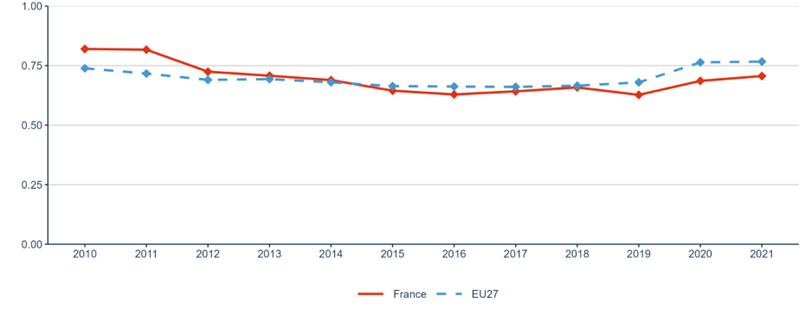
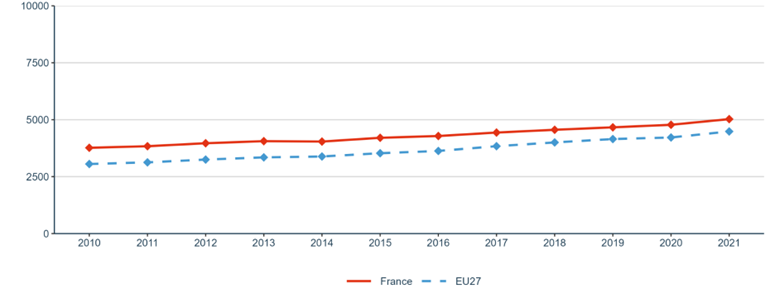

Priority 1: Deepening a truly functioning internal market for knowledge
Sub-priority 1.1: Open Science
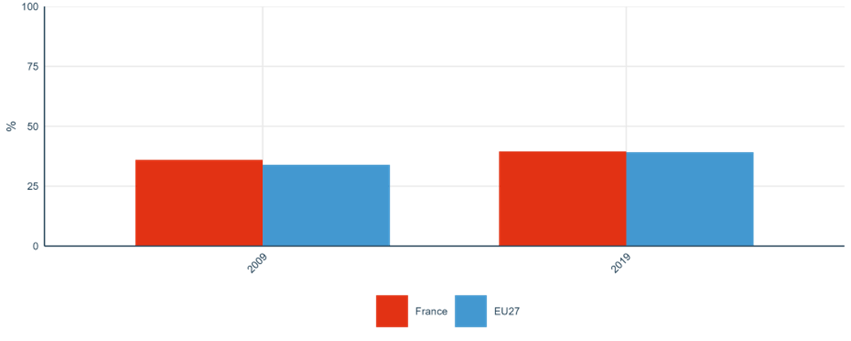
Sub-priority 1.2: Research infrastructures

Sub-priority 1.3: Gender equality, equal opportunities for all and inclusiveness
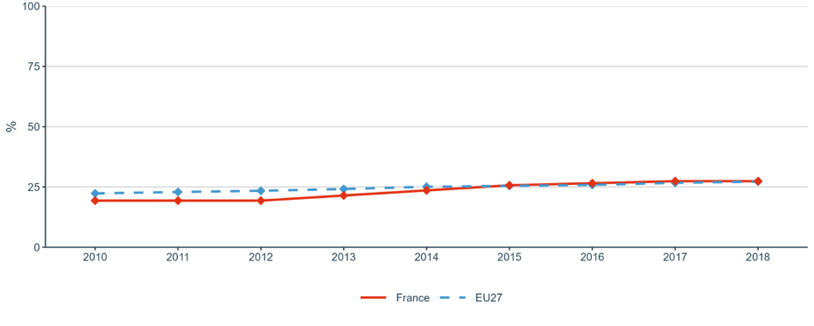
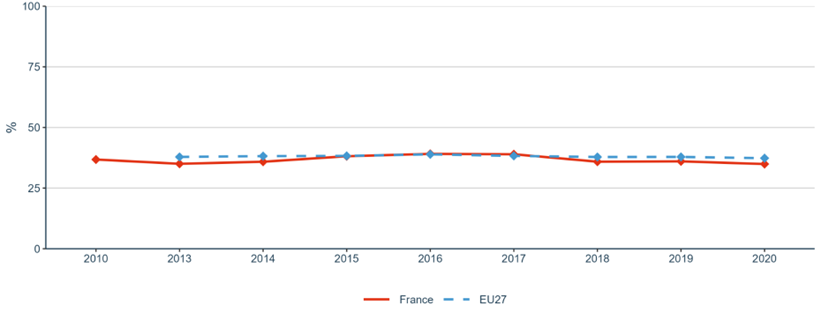
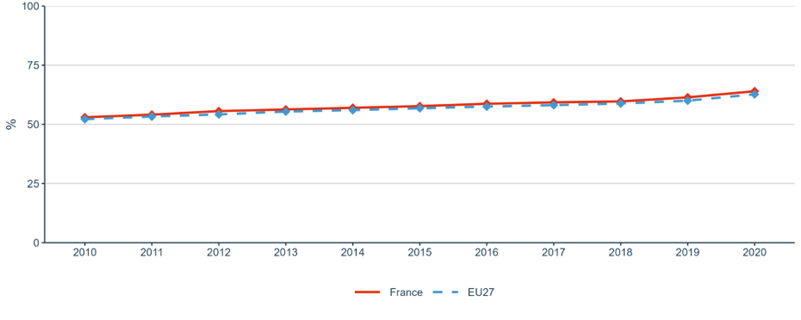


Sub-priority 1.4: Researchers’ careers and mobility and research assessment and reward systems
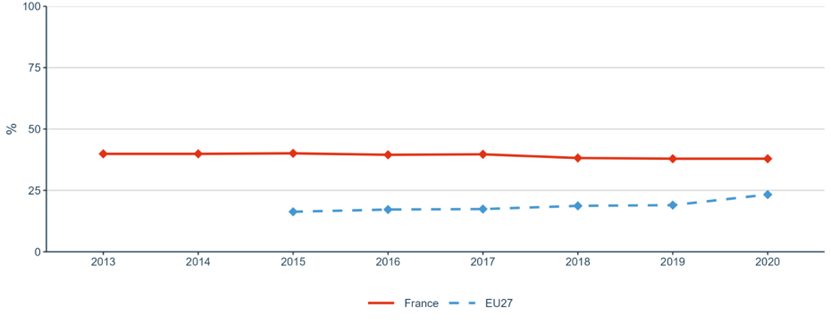

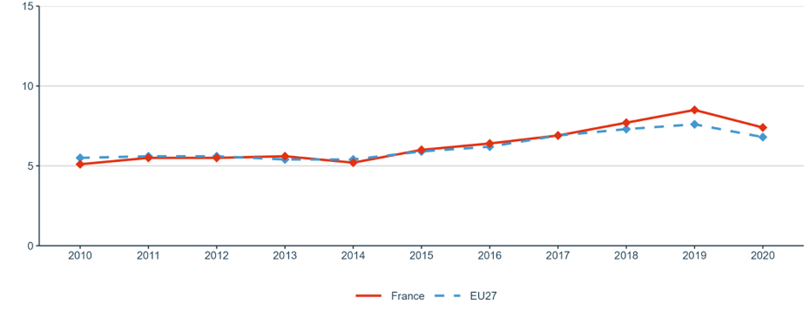
Sub-priority 1.5: Knowledge valorisation



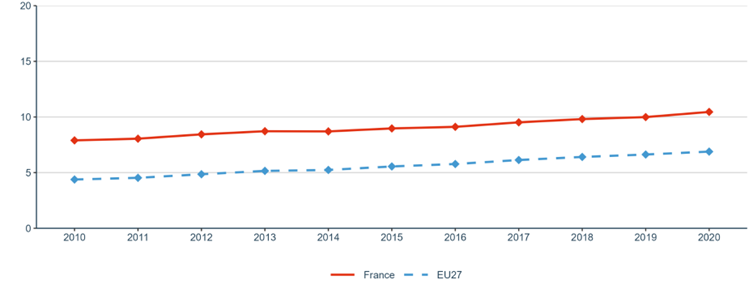

Sub-priority 1.6: Scientific leadership
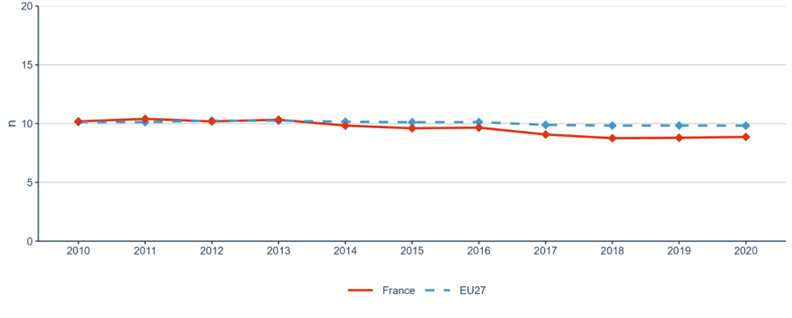
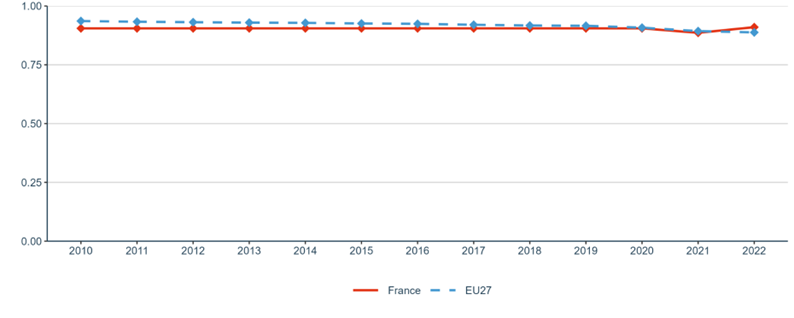
Sub-priority 1.7: Global engagement
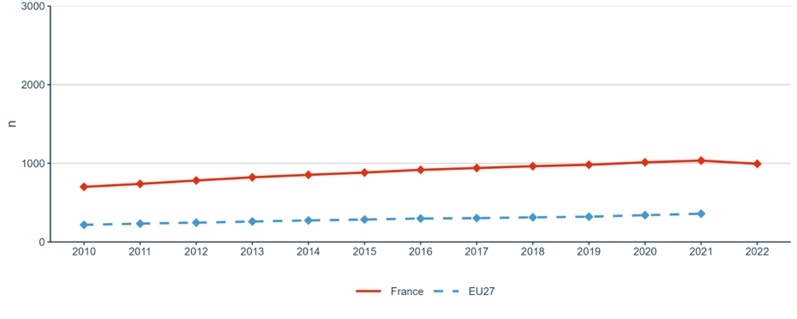

Priority 2: Taking up together the challenges posed by the twin green and digital transition, and increasing society’s participation in the ERA
Sub-priority 2.1: Challenge-based ERA actions
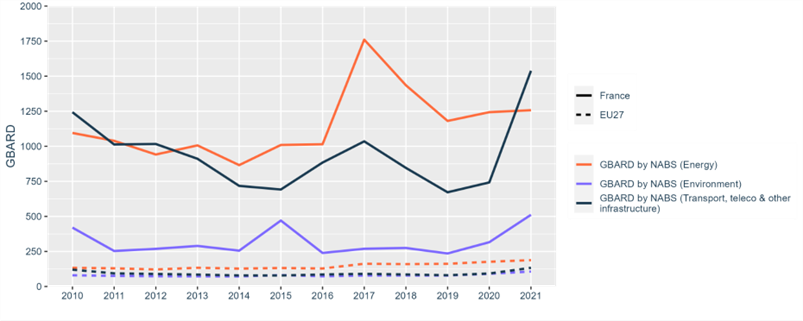
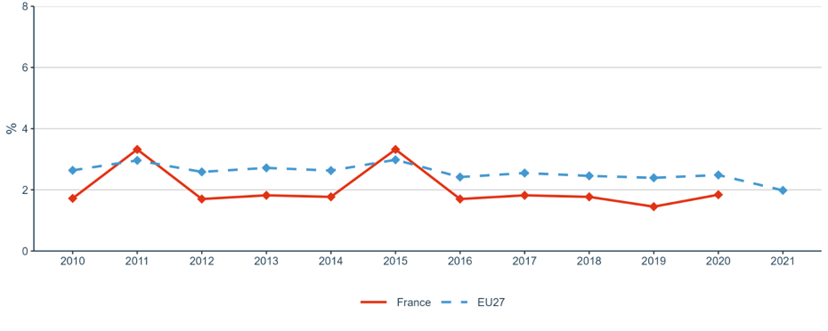


Sub-priority 2.2: Synergies with education and the European Skills Agenda

Sub-priority 2.3: Synergies with sectorial policies and industrial policy, in order to boost innovation ecosystems
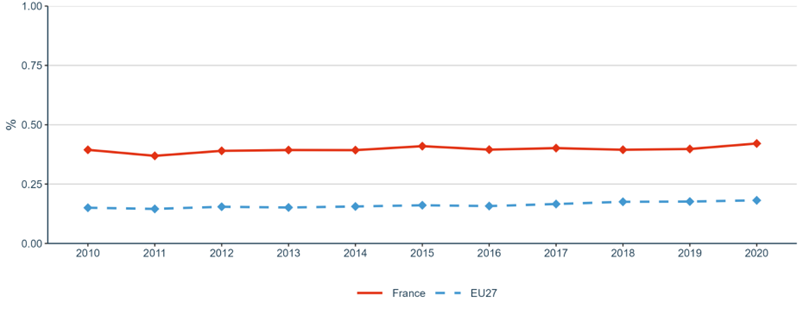
Sub-priority 2.4: An active citizen and societal engagement in R&I in all its dimensions
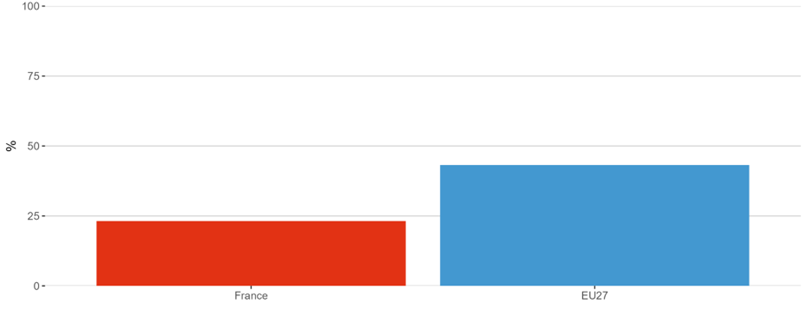
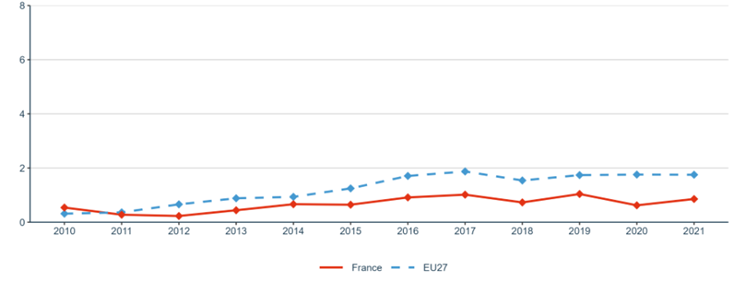
Priority 3: Amplifying access to research and innovation excellence across the Union
Sub-priority 3.1: More investments and reforms in countries and regions with lower R&I performance
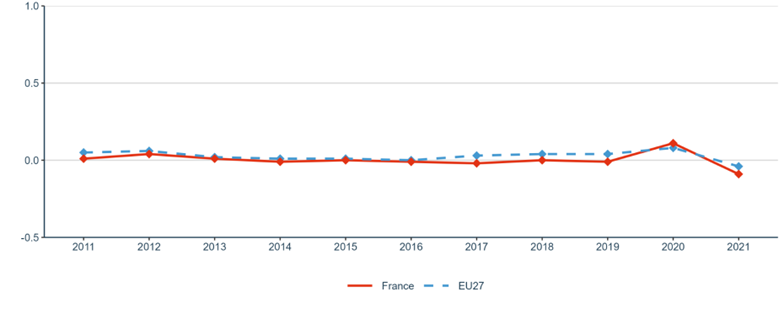
Priority 4: Advancing concerted research and innovation investments and reforms
Sub-priority 4.1: Coordination of R&I investments

